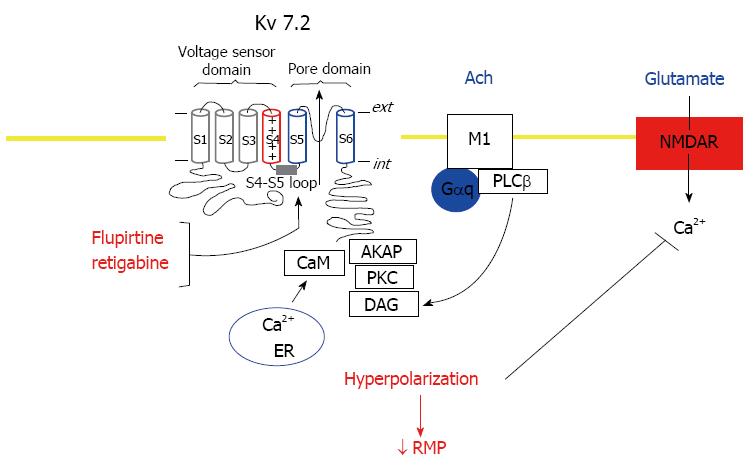Copyright
©The Author(s) 2018.
World J Pharmacology. Oct 22, 2018; 7(1): 1-9
Published online Oct 22, 2018. doi: 10.5497/wjp.v7.i1.1
Published online Oct 22, 2018. doi: 10.5497/wjp.v7.i1.1
Figure 1 Schematic of a Kv7.
2 subunit with activators flupirtine and retigabine. Flupirtine and retigabine activate Kv7.2/7.3 channel complexes resulting in efflux of K+ leading to hyperpolarization and concomitant decrease in the resting membrane potential. Kv7.2/7.3 channel complexes are inhibited due to the release of calcium from the endoplasmic reticulum and the activation of M1-type muscarinic receptors by acetylcholine. Excessive levels of glutamate activating N-methyl-D-aspartic acid receptors which leads to an influx of Ca2+ ions into neurones is indirectly antagonised by the retigabine- or flupirtine-induced hyperpolarization suppressing free intracellular Ca2+ ion levels reducing neuronal excitability. AKAP: A-kinase anchoring protein; CaM: Calmodulin; NMDAR: N-methyl-D-aspartic acid receptor; PKC: Protein kinase C; PLCβ: Phospholipase C.
- Citation: Lawson K. Kv7 channels a potential therapeutic target in fibromyalgia: A hypothesis. World J Pharmacology 2018; 7(1): 1-9
- URL: https://www.wjgnet.com/2220-3192/full/v7/i1/1.htm
- DOI: https://dx.doi.org/10.5497/wjp.v7.i1.1









